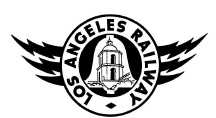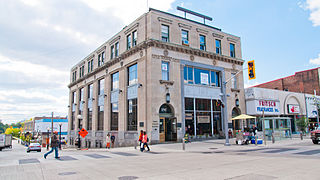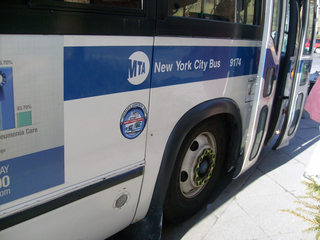
Streetcars in Washington, D.C. transported people across the city and region from 1862 until 1962.

The Los Angeles Railway was a system of streetcars that operated in Central Los Angeles and surrounding neighborhoods between 1895 and 1963. The system provided frequent local services which complemented the Pacific Electric "Red Car" system's largely commuter-based interurban routes. The company carried many more passengers than the Red Cars, which served a larger and sparser area of Los Angeles.

Pittsburgh Railways was one of the predecessors of Pittsburgh Regional Transit. It had 666 PCC cars, the third largest fleet in North America. It had 68 streetcar routes, of which only three are used by the Port Authority as light rail routes. With the Port Authority's Transit Development Plan, many route names will be changed to its original, such as the 41D Brookline becoming the 39 Brookline. Many of the streetcar routes have been remembered in the route names of many Port Authority buses.

The Kitchener Public Utilities Commission was the municipal public utilities commission for the city of Kitchener, Ontario, Canada, as well as the surrounding area. Its former office in downtown Kitchener, constructed in 1931 in Beaux-Arts style, has been designated under the Ontario Heritage Act as both historically and architecturally significant, and is one of the Kitchener's few surviving historic public buildings.

The history of Bridgeport, Connecticut was, in the late 17th and most of the 18th century, one of land acquisitions from the native inhabitants, farming and fishing. From the mid-18th century to the mid-19th century, Bridgeport's history was one of shipbuilding, whaling and rapid growth. Bridgeport's growth accelerated even further from the mid-19th century to the mid-20th century with the advent of the railroad, Industrialization, massive immigration, labor movements until, at its peak population in 1950, Bridgeport with some 159,000 people was Connecticut's second most populous city. In the late 20th century, Bridgeport's history was one of deindustrialization and declining population, though it overtook Hartford as the state's most populous city by 1980.

MTA Regional Bus Operations operates local and express buses serving New York City in the United States out of 29 bus depots. These depots are located in all five boroughs of the city, plus one located in nearby Yonkers in Westchester County. 21 of these depots serve MTA New York City Transit (NYCT)'s bus operations, while the remaining eight serve the MTA Bus Company These facilities perform regular maintenance, cleaning, and painting of buses, as well as collection of revenue from bus fareboxes. Several of these depots were once car barns for streetcars, while others were built much later and have only served buses.
The Capital Traction Company was the smaller of the two major street railway companies in Washington, D.C., in the early 20th century.

The Union Street Railway Carbarn, Repair Shop is a historic transit maintenance facility of the Union Street Railway Company at 1959 Purchase Street in New Bedford, Massachusetts. Built in 1910, the carbarn was the center of the New Bedford's streetcar network, which operated from 1872 to 1947. The carbarn is a large single-story brick building, occupying nearly half of a city block. The adjacent repair shop building, a single-story brick-and-wood building, was built in 1897; it was demolished sometime between 1978 and 2003.

The Pequonnock River Railroad Bridge is a railroad drawbridge over the Pequonnock River in Bridgeport, Connecticut. Owned by the State of Connecticut and maintained and operated by both Amtrak and Metro-North Railroad, it is also referred to as Pequonnock River Bridge, PECK Bridge, and Undergrade Bridge 55.90. Currently the bridge is part of the Northeast Corridor line, carrying rail traffic of Amtrak and Metro-North, as well as freight trains operated by the Providence & Worcester Railroad.

The former Yonkers Trolley Barn is located on Main Street in Yonkers, New York, United States. It is a massive steel frame brick building in the Renaissance Revival style built at the beginning of the 20th century. In 2002 it was listed on the National Register of Historic Places as the last remaining trolley barn in Westchester County and the only remnant of Yonkers' trolley system.
The Bridgeport Traction Company was a streetcar transit company in the area around Bridgeport, Connecticut. The company was incorporated in 1893 through the consolidation of the Bridgeport Horse Railroad Company, Bridgeport Railway Company, and the East End Railway Company. The East End Railway Company was established in 1895 as the Bridgeport and West Stratford Horse Railroad Company. The Bridgeport Horse Railroad Company was incorporated in 1864. The Bridgeport Railway Company was formed in 1893. At the time, streetcars were a more affordable form of transportation for those commuting between Bridgeport and Norwalk. Using streetcars to get to their destination was half the price of using the train. In 1899 president Andrew Radel formed a company that was intended to control the world's oyster trade.
Connecticut Railway and Lighting Company was a streetcar and bus transit operator serving the region around Bridgeport, Norwalk, Derby, New Britain and Waterbury, Connecticut. It was formed in 1901 by United Gas Improvement Company of Philadelphia to manage the streetcar operations of the Connecticut Light and Power Company, which at the time included Central Railway and Electric Company, Norwalk Street Railway, and the Waterbury Traction Company. The newly formed Connecticut Railway and Lighting acquired Bridgeport Traction Company, Derby Street Railway, Milford Street Railway, Shelton Street Railway, Meriden, Southington and Compounce Tramway Company, and the Cheshire Street Railway. Connecticut Railway and Lighting was leased to the Consolidated Railway and in turn the Connecticut Company between 1906 and 1936. Streetcar operations were discontinued in 1937 when all lines were converted to bus. Transit operations continued until 1972, when all remaining bus operations were suspended and taken over by Connecticut Transit, except in Bridgeport- by the Greater Bridgeport Transit District in 1975.

The Redlands Central Railway Company car barn is a historic car barn located at 746 East Citrus Avenue in Redlands, California, United States. The building was used to house electric railway cars, first for the Redlands Central Railway and later for the Pacific Electric Railway. It is the only extant Pacific Electric car barn, and one of only two trolley barns remaining in Southern California.

Carolina Power and Light Company Car Barn and Automobile Garage is a historic streetcar barn and automobile repair shop located at Raleigh, North Carolina. It built in 1925 and is a one-story, rectangular brick building in the Art Deco style. It measures 210 feet and 6 inches in length and 59 feet and 7 inches in width and features terra cotta ornamentation. The building was originally built to house the Carolina Power and Light Company's electric streetcars and buses and was converted to automotive and service vehicle storage in the 1940s.

Hillcrest Complex, the Toronto Transit Commission's largest facility, is responsible for most of the maintenance work on the system's surface vehicles, including heavy overhauls, repairs, and repainting. It is located adjacent to the intersection of Bathurst Street and Davenport Road. The site is also home to the TTC's Transit Control Centre, but the operational headquarters of the organization remains at the McBrien Building, at 1900 Yonge Street.

The Burlington Traction Company is a historic trolley maintenance facility at Riverside Avenue and North Winooski Avenue in Burlington, Vermont. The property includes two brick trolley barns, built c. 1900 and c. 1910 respectively, that were used as public transit maintenance facilities until 1999, after which they were adaptively repurposed to other residential and commercial uses. The property was listed on the National Register of Historic Places in 2004.

The Wethersfield Avenue Car Barn, also known locally just as the Trolley Barn, is a historic trolley barn at 331 Wethersfield Avenue in Hartford, Connecticut. Built in 1902, it is the only surviving building used exclusively for the area's extensive electrified street car network in the first half of the 20th century. Now converted to other uses, it was listed on National Register of Historic Places in 1983.

The Capital Traction Company Car Barn is a historic streetcar car barn in northwest Washington, D.C. Built in 1906 by the Capital Traction Company, it was later turned into a bus garage and is currently owned by Washington Metropolitan Area Transit Authority.

The Georgetown Car Barn, historically known as the Capital Traction Company Union Station, is a building in the Georgetown neighborhood of Washington, D.C., in the United States. Designed by the architect Waddy Butler Wood, it was built between 1895 and 1897 by the Capital Traction Company as a union terminal for several Washington and Virginia streetcar lines. The adjacent Exorcist steps, later named after their appearance in William Friedkin's 1973 horror film The Exorcist, were built during the initial construction to connect M Street with Prospect Street.


















